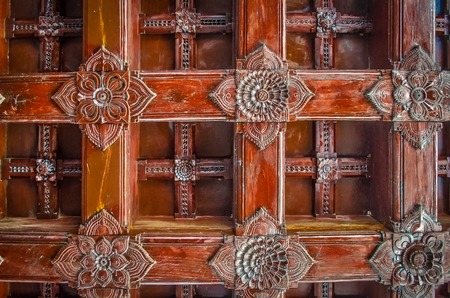Essence of Indian Traditional Furniture
Step into the soulful world of Indian traditional furniture, where every piece carries the fragrance of nostalgia and echoes of heritage. Rooted deeply in the subcontinent’s vibrant culture, these masterpieces are more than mere objects—they embody the warmth of Indian homes and the spirit of timeless artistry. Crafted predominantly from rich woods like pine and teak, Indian furniture is celebrated for its exquisite carvings, each motif telling tales handed down through generations. Whether it’s a grand jharokha mirror or a humble charpai, these handcrafted pieces are not just functional but also serve as living expressions of India’s artistic legacy, seamlessly blending utility with cultural symbolism. In today’s ever-evolving design narrative, Indian traditional furniture remains a beloved choice, infusing interiors with authentic character and a sense of belonging.
2. Unravelling the Beauty of Pine and Teak
In the vibrant tapestry of Indian traditional furniture, pine and teak wood hold a cherished place that transcends generations. These two woods are not just materials; they are companions in daily life, deeply woven into the heritage of Indian households. Their popularity is more than mere tradition—it is rooted in practical brilliance, beauty, and an innate ability to adapt to India’s rich climatic diversity.
The Allure of Resilience: Pine vs. Teak
Both pine and teak have a unique story in Indian homes. Teak, known locally as “Sagwan,” is celebrated for its exceptional durability and resistance to termites—a blessing in humid regions like Kerala or coastal Maharashtra. Pine, on the other hand, offers a lighter touch with its soft grain and approachable price point, making it an accessible favourite for many families, especially in North India. The table below captures their individual strengths:
| Feature | Pine Wood | Teak Wood |
|---|---|---|
| Resilience | Moderate; needs care against moisture | High; naturally termite-resistant |
| Texture & Grain | Smooth, light-hued with visible knots | Rich, dark golden-brown; tight grain |
| Suitability for Climate | Best in drier areas (Punjab, Rajasthan) | Ideal for all climates across India |
| Cultural Value | Popular in contemporary settings | Heirloom status; often passed down generations |
| Maintenance Required | Low to moderate; occasional polishing needed | Minimal; ages gracefully with time |
The Subtle Artistry of Texture & Tone
Pine’s pale complexion brings an airy freshness—perfect for spaces aiming for a blend of tradition and modernity. Its natural knots and grains evoke a rustic charm seen in Punjabi kothis or Himalayan cottages. Teak’s deep golds and browns exude regal warmth, a staple in stately south Indian homes or ancestral havelis where every piece tells a story.
A Harmony with India’s Diverse Climates
The adaptability of these woods is remarkable. From the arid deserts of Rajasthan to the monsoon-kissed coasts of Tamil Nadu, pine and teak withstand humidity, heat, and even fluctuating temperatures. This resilience means that a handcrafted teak jhoola (swing) or pine almirah stands strong through decades, holding memories as much as it holds daily essentials.
A Timeless Choice Rooted in Culture
This love affair with pine and teak is no fleeting trend. It speaks of careful selection—an appreciation for materials that echo the Indian ethos: strength balanced with grace, endurance married to elegance. Whether it’s the aroma of fresh pine or the smooth caress of polished teak beneath your palm, each piece reflects a legacy lovingly preserved within Indian homes.

3. Artistry in Exquisite Wood Carvings
When we speak of Indian traditional furniture, the heart and soul truly lie in the breathtaking woodwork that adorns every piece. This intricate artistry is not merely decorative—it tells stories, preserves history, and weaves together generations of craft traditions. From North to South, every region brings its own flavour and finesse to wood carving, making each creation a unique celebration of cultural identity.
The Language of Motifs: Regional Narratives in Wood
Travel to Rajasthan, and you will be greeted by the iconic jharokhas—ornate window frames featuring latticework patterns that let in dappled desert light. These are more than just architectural elements; they are symbolic of royal heritage and Marwari grandeur. In contrast, venture into the vibrant homes of Gujarat or Maharashtra, and discover furniture adorned with delicate floral engravings, geometric patterns, and playful depictions of daily village life.
South Indian Splendour: Temple-Inspired Carvings
In Southern India, temple architecture breathes life into traditional furniture design. Here, artisans draw inspiration from Dravidian temples—their columns, mythological figures, and sacred motifs manifest in bedposts, chests, and chairs. Intricate depictions of peacocks, elephants, and divine deities are lovingly hand-carved into dense teak or rosewood, echoing centuries-old rituals and spiritual beliefs.
Mastery in Every Detail
No two pieces are ever truly alike. Whether it is the gently curved arms of a Kerala oonjal (traditional swing) or the bold lion paws carved on a Bengali four-poster bed, Indian craftsmen pour their soul into each detail. The patience required for such meticulous work is immense—a single carved panel can take weeks to complete using traditional chisels and hand tools.
In every home where these masterpieces reside, they offer more than comfort or utility—they stand as living testimonies to India’s unparalleled artistic legacy. Indian traditional furniture is not just about form or function; it is about honouring the hands that keep our heritage alive through exquisite wood carvings.
4. Signature Designs across India
India’s traditional furniture is a vibrant showcase of regional creativity, history, and the seamless integration of function with aesthetics. Each region boasts unique forms, materials, and artistic expressions, transforming ordinary living spaces into visual narratives that echo centuries of tradition. Let us journey through some of the most iconic designs that have stood the test of time and continue to embellish Indian homes.
Mughal-Inspired Diwans: Grandeur Redefined
The diwan, inspired by Mughal opulence, is more than just a seat—it is an experience. With intricate wood carvings in teak or rosewood, low seating, and plush upholstery, these diwans are often the centerpiece of drawing rooms. They blend luxurious comfort with detailed artistry, making them perfect for hosting guests or a quiet evening chai. The curved armrests and ornate legs speak volumes about Indias royal past while embracing contemporary utility.
Colonial-Era Almirahs: Fusion of Eras
The stately almirah is a vestige of colonial times when British sensibilities merged with Indian craftsmanship. These wardrobe cabinets are constructed from sturdy pine or seasoned teak and exhibit a fusion of straight lines with delicate motifs. Brass handles, beveled mirrors, and paneled doors add a touch of old-world charm, making each almirah a blend of utility and nostalgia—an heirloom passed down generations.
Gujarati Chowkis: Vibrant Heritage at Your Feet
No discussion on Indian traditional furniture is complete without mentioning the Gujarati chowki—a low stool or table that embodies the vivacious spirit of Gujarat. Crafted from mango or sheesham wood and adorned with colorful hand-painted patterns or mirror work, these chowkis are versatile accents for pooja rooms or festive gatherings. Their bold hues and folk-inspired motifs infuse any space with warmth and joy.
Signature Furniture Styles Across Regions
| Region | Signature Piece | Wood Used | Distinctive Feature |
|---|---|---|---|
| North India (Mughal) | Diwan | Teak/Rosewood | Intricate carvings, low seating |
| Western India (Gujarat) | Chowki | Mango/Sheesham | Vivid colors, mirror work |
| Pan-India (Colonial Influence) | Almirah | Pine/Teak | Paneled doors, brass fittings |
A Living Legacy in Every Home
The signature designs of Indian traditional furniture not only reflect regional diversity but also embody stories—stories of empires, artisans, and everyday life. Whether it is the regal diwan in your living room or the humble chowki in your pooja corner, each piece resonates with cultural pride and timeless functionality.
5. Sustainability meets Craftmanship
In the heart of India’s traditional furniture industry, a remarkable synergy between sustainability and craftsmanship is taking root. Today, eco-friendly sourcing is not just a trend—it has become an essential part of how Indian artisans create exquisite pieces from pine, teak, and other indigenous woods. The forests of Kerala, Rajasthan, and Uttar Pradesh are being protected through responsible harvesting, ensuring that the natural beauty of these timbers endures for generations.
Reviving Heritage, Embracing the Future
Local craftsmen—often referred to as “karigars”—are reviving age-old woodworking traditions that have been passed down through generations. Their intricate carvings, which once adorned royal palaces and havelis, are now crafted using sustainable methods. By choosing locally sourced wood and utilising non-toxic finishes, these artisans weave environmental consciousness into every piece they create. This thoughtful approach preserves both cultural heritage and the health of our planet.
Modern Sensibilities in Traditional Designs
While rooted in tradition, today’s Indian furniture makers are also adapting to contemporary lifestyles. Sleek lines meet ornate carvings; minimalist forms are paired with classic motifs. This blend caters to urban tastes while maintaining authenticity. Sustainability is celebrated in the choice of materials—reclaimed wood, certified timbers, and plant-based varnishes are increasingly popular among discerning customers who value both style and substance.
Empowering Communities, Supporting Local Economies
The revival of traditional practices is more than an aesthetic movement; it empowers rural communities and sustains livelihoods. When you invest in handcrafted Indian furniture made from responsibly sourced pine or teak, you support local karigars who pour their skill and soul into each creation. As India moves towards a greener tomorrow, its rich legacy of wooden artistry continues to inspire eco-conscious living across the globe.
6. Adding a Touch of Tradition to Modern Spaces
Blending Heritage with Contemporary Living
India’s rich legacy of traditional furniture, whether it is the sturdy pine chests from Himachal or the intricate teakwood carvings of Rajasthan, offers an endless palette for interior inspiration. For urban dwellers looking to evoke warmth and nostalgia in their homes, integrating these iconic pieces into modern settings creates an inviting dialogue between the old and the new.
Choose Statement Pieces Thoughtfully
Select one or two standout items—perhaps a hand-carved jharokha mirror or a solid teak diwan—to anchor your room. Let these pieces shine by keeping surrounding décor minimal and complementary. The juxtaposition of clean lines and ornate woodwork not only honours Indian craftsmanship but also keeps the aesthetic uncluttered and soulful.
Balance Colour, Texture, and Motifs
Indian traditional furniture often boasts earthy tones and intricate motifs. Pair them with neutral walls or contemporary textiles in block prints to strike a harmonious balance. Layering textures—think khadi cushions on a carved bench—adds tactile richness without overwhelming the senses. Remember, subtlety is key; a splash of vibrant colour through Rajasthani throws can enliven even the sleekest urban space.
Cultural Nuances: Respecting Roots
When blending Indian classics into modern interiors, consider placement as per vastu shastra for positive energy flow. Display heirloom items or antiques with pride, perhaps accompanied by a story card or family anecdote that celebrates their heritage. The respect for history and craftsmanship is what truly elevates your décor from mere design to soulful storytelling.
Create a Timeless Ambience
The magic lies in curating spaces that feel personal yet universal—a carved wooden almirah beside a modern sofa, brass handles gleaming against minimalist cabinetry, or an old-world swing (jhoola) in a sunlit corner. These thoughtful touches transcend trends, offering comfort, connection, and timeless beauty rooted in India’s design traditions.


